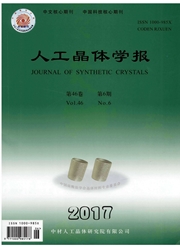

 中文摘要:
中文摘要:
采用甘露醇辅助水热法合成了BiPO4光催化剂,并以罗丹明B为目标降解物考察其光催化活性。采用XRD、SEM、FFIR、UV—vis DRS和N2吸附对产物进行了表征。结果表明,170℃水热24h条件下甘露醇的加入不改变产物晶型,而产物的形貌从棱柱状变为多面体,随着加入量的增多,多面体尺寸减小,继续增大加入量,产物形貌出现分级结构的趋势。水热温度低或时间短时,产物为六方相,呈端面有突起的棒状,水热温度升高或时间延长,产物为单斜相,呈多面体状。但结晶度均较高。单斜相产物的形成经历了六方相的转变过程。所得产物结构中不含甘露醇,但有结晶水。170℃下甘露醇辅助制得的单斜相BiPO4的光催化活性最高,无甘露醇的条件下得到的单斜相产物的光催化活性次之,110℃下甘露醇辅助制得的六方相产物活性最差,这可能与它们的光响应范围大小不同有关。
 英文摘要:
英文摘要:
BiPO4 photocatalysts were prepared by mannitol-assisted hydrothermal method and the photocatalytic acitivities for degradating rhodamine B were investigated. The BiPOg products were characterized by XRD, SEM, FHR and UV-vis DRS and N2 adsorption techniques. The results show that the addition of mannitol doesnt change the crystal structure of the product. But Prismatic BiPO4 changes into polyhedral BiPO4 when hydrothermal reaction takes place at 170 ℃ for 24 h. Moreover, the size of polyhedron decreased with an increase in the addition amount of mannitol. A further increase might result in the hierarchical structure. Lower hydrothermal temperature or shorter time makes for hexagonal phase BiPO4 in rod-like shape with protuberances on its cross sections. Higher temperature or longer time makes for monoclinie phase. Nevertheless, the crystallinity degrees are both high. Monoelinic product formation experiences a hexagonal phase transition. There is no mannitol molecule but crystal water in products. The monoclinie BiPO4 obtained at 170 ℃ with mannitol assistance shows the highest photocatalytic activity, which is superior to that of the BiPO4 obtained without mannitol assistance. The hexagonal one obtained at 110 ℃ shows the lowest activity. Light response range may be the reason for the different photocatalytic activity.
 同期刊论文项目
同期刊论文项目
 同项目期刊论文
同项目期刊论文
 Preparation and photocatalytic property of hexagonal cylinder-like bipods ZnO microcrystal photocata
Preparation and photocatalytic property of hexagonal cylinder-like bipods ZnO microcrystal photocata Preparation and Electrochemical Performance of LiNi1/3Co1/3Mn1/3O2 Cathode Materials for Lithium-ion
Preparation and Electrochemical Performance of LiNi1/3Co1/3Mn1/3O2 Cathode Materials for Lithium-ion Recovery ofCo,Mn,Ni,andLifromspentlithiumionbatteriesforthe preparation ofLiNixCoyMnzO2 cathode mate
Recovery ofCo,Mn,Ni,andLifromspentlithiumionbatteriesforthe preparation ofLiNixCoyMnzO2 cathode mate MnZn ferritesynthesizedbysol–gel auto-combustionandmicrowave digestion routesusingspentalkalinebatte
MnZn ferritesynthesizedbysol–gel auto-combustionandmicrowave digestion routesusingspentalkalinebatte Effects onmagneticpropertiesofdifferentmetalionssubstitutioncobalt ferritessynthesisbysol–gelauto-co
Effects onmagneticpropertiesofdifferentmetalionssubstitutioncobalt ferritessynthesisbysol–gelauto-co 期刊信息
期刊信息
